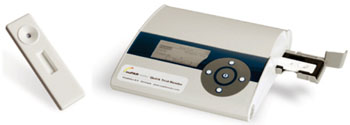Early Warning Biomarker Found for Chronic Kidney Disease
By LabMedica International staff writers
Posted on 18 Nov 2015
A simple blood test for a specific protein can predict a person's chances of developing chronic kidney disease five years before symptoms emerge, thus doing for kidney disease what cholesterol has done for cardiovascular disease. Posted on 18 Nov 2015
Relatively high plasma levels of the specific protein soluble urokinase-type plasminogen activator receptor (suPAR) have been associated with focal segmental glomerulosclerosis and poor clinical outcomes in patients with various conditions.
Scientists at Rush University Medical Center (Chicago, IL, USA) and a large team of collaborators, measured plasma suPAR levels in 3,683 persons enrolled in the Emory Cardiovascular Biobank and determined renal function at enrollment. Their mean age was 63 years; 65% were men; and the median suPAR level, 3,040 pg/mL and at subsequent visits in 2,292 persons. The relationship between suPAR levels and the estimated glomerular filtration rate (eGFR) at baseline, the change in the eGFR over time, and the development of chronic kidney disease (eGFR <60 mL per minute per 1.73 m2 of body-surface area) were analyzed.
Serum concentrations of high-sensitivity C-reactive protein (CRP) were determined with the use of a particle-enhanced immunoturbidimetry assay (FirstMark; GenWay Biotech, San Diego, CA, USA) that has a lower limit of detection of 0.03 mg/L. Plasma levels of suPAR were measured with the suPARnostic kit (ViroGates; Birkerød, Denmark), which has a lower limit of detection of 100 pg/mL. The intra-assay variation is 2.75% and the interassay variation is 9.17%.
Of the 2,292 enrollees, 40% of subjects with high suPAR levels, greater than 3,040 ng/mL but no known kidney disease as indicated by, healthy eGFR levels, went on to develop chronic kidney disease over the course of five years. In comparison, only 10% of those with low suPAR levels at baseline developed the disease. Moreover, suPAR was shown to predict eGFR decline in patients with already established earlier stage kidney disease as well. From a cohort of patients with cardiovascular disease, the study divides suPAR levels into four quartiles: normal suPAR: less than 2,373 pg/mL; above normal: 2,373–3,030 pg/mL, high: 3,040–4,020 pg/mL, and very high: above 4,020 pg/mL.
Sanja Sever, PhD, the study's co-first author, said, “What we've shown is that it doesn't matter whether our subjects were black or white. SuPAR was a strong independent predictor of eGFR decline. APOL1 gene polymorphism is a genetic risk factor for renal disease in the black population, but suPAR's power to predict renal disease appeared not be majorly different in black or white patients.” The authors concluded that elevated plasma suPAR levels were associated with incident chronic kidney disease and a more rapid decline in the eGFR in persons with normal kidney function at baseline. The study was published on November 5, 2015, in the New England Journal of Medicine.
Related Links:
Rush University Medical Center
FirstMark
ViroGates
















